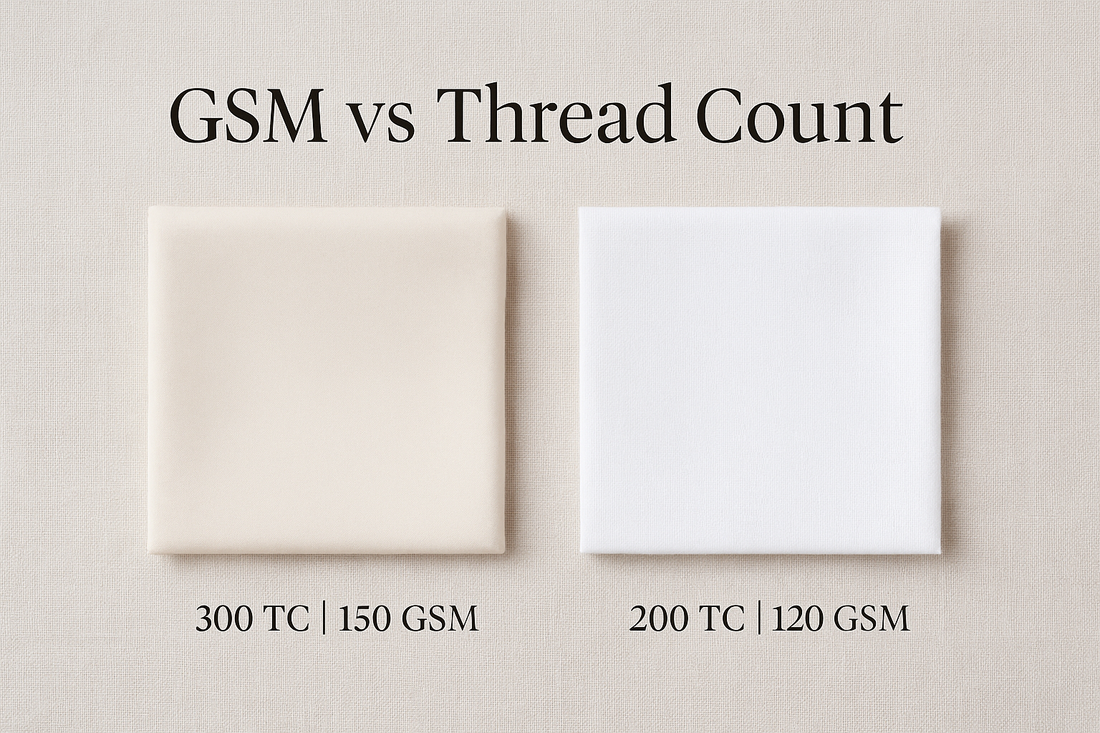
GSM vs Thread Count: What Actually Determines the Quality of a Bedsheet?
If you’ve ever shopped for bedsheets online or in-store, chances are you’ve come across two numbers: thread count and GSM. One is often used to imply luxury. The other rarely gets explained at all.
But here’s the truth: neither number on its own tells you everything. A high thread count doesn’t always mean high quality. And GSM? Most people don’t even know what it stands for.
So let’s break down what these two terms really mean, and how they affect the way your bedsheet feels, performs, and lasts.
What is Thread Count?
Thread count is the number of threads woven into one square inch of fabric. It includes both horizontal (weft) and vertical (warp) threads.
It’s often marketed as a badge of quality, but beyond a certain point, it’s mostly marketing. A good 200–300 thread count sheet in long-staple cotton can feel better than a 1000 thread count sheet made from poor-quality or multi-ply threads.
What really matters more than the number is:
- The type of cotton used
- The weave
- Whether single-ply or multi-ply yarns were used
- The finishing process (stone-washed, mercerized, etc.)
So while thread count does affect how dense or smooth a sheet feels, it’s not the sole indicator of quality.
What is GSM?
GSM stands for grams per square metre. It measures the weight of the fabric, not the number of threads.
In clothing, GSM is commonly used to describe t-shirts, towels, and hoodies. But it matters just as much in bedding.
Here’s how GSM affects bedsheets:
- A higher GSM sheet will feel thicker, denser, and more substantial
- A lower GSM sheet will feel lighter, airier, and more breathable
For example:
- 110–140 GSM → Light, summer-friendly sheets (often 200 TC percale)
- 140–170 GSM → Balanced weight with comfort and durability (common in 300 TC sateen)
- 180+ GSM → Heavyweight sheets, often for cooler climates or decorative use
Unlike thread count, GSM tells you more about the actual feel and heft of a sheet.
So Which Matters More?
That depends on what you're looking for.
Thread count affects how smooth or tight the weave feels.
GSM affects how heavy, thick, or breathable the fabric is.
In most quality bedsheets, the two work together:
- A 300 TC sateen cotton sheet might have a GSM of 150–160, feeling soft and drapey
- A 200 TC percale sheet might have a GSM of 120, feeling crisp and airy
- A 500 TC multi-ply sheet might have a high GSM, but feel dense, stuffy, and less breathable
So instead of chasing the highest number, focus on the combination of thread count, GSM, weave, and fiber type.
What You Should Really Pay Attention To
When evaluating a bedsheet, ask:
- What fiber is used? (100% cotton, or a blend?)
- Is the cotton long-staple or short-staple?
- What’s the weave — percale, sateen, dobby?
- Is the thread count within a healthy, breathable range (200–400)?
- Is the GSM suited to your climate and comfort preference?
And most importantly: how does it feel when you touch it?
Luxury doesn’t always lie in numbers. It lies in how a bedsheet performs night after night, whether it stays cool, holds its shape, and becomes better with every wash.
In Summary
Thread count and GSM both tell part of the story, but never the whole.
Thread count shapes the texture. GSM shapes the weight. Neither tells you anything about fiber quality, finishing, or real-world comfort.
At Cloud Comfort, we use premium long-staple cotton and weave-specific GSM standards for each product line, whether crisp percale or smooth sateen, to make sure every sheet delivers exactly what it promises. We don’t inflate numbers. We build comfort you can feel.
In our next post, we’ll shift gears and explore how to care for your cotton bedsheets, the do’s, the don’ts, and how simple habits can extend the life of your linens for years.
